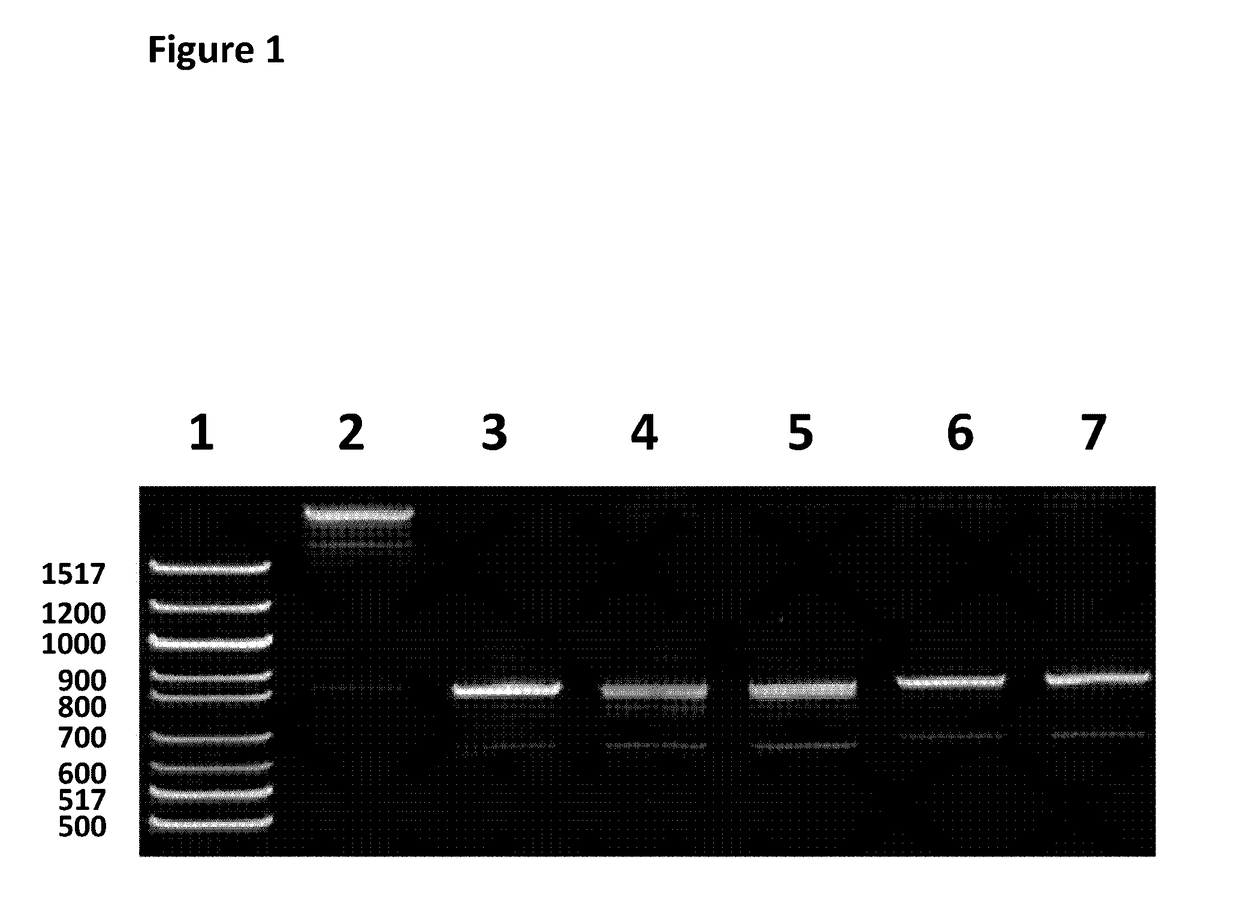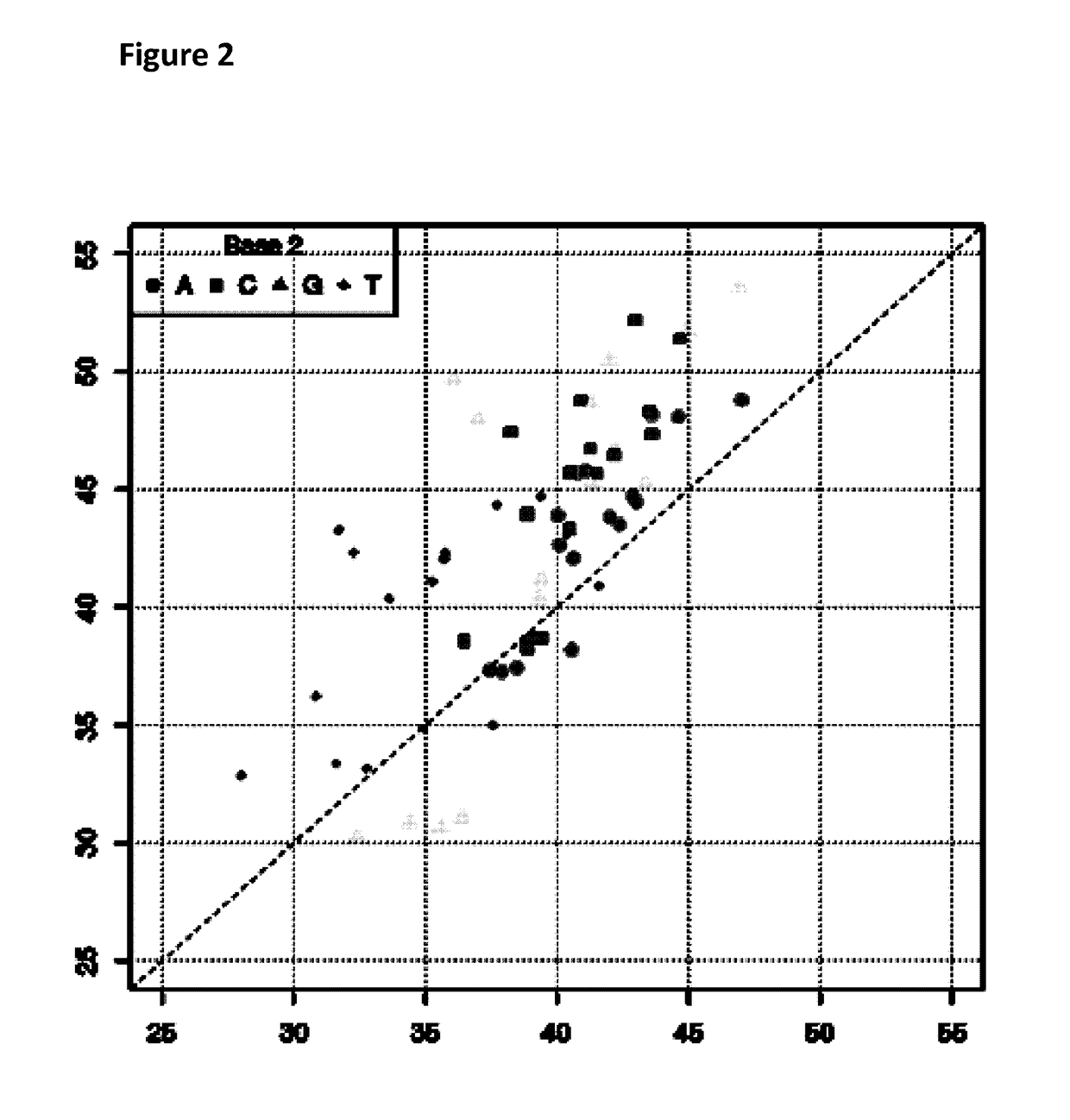Sample preparation method
a preparation method and sample technology, applied in the field of sample preparation method, can solve problems such as the difficulty of resolving the measurement produced by different k-mers
- Summary
- Abstract
- Description
- Claims
- Application Information
AI Technical Summary
Benefits of technology
Problems solved by technology
Method used
Image
Examples
example 1
[0263]This example describes how 600 bp strands of DNA were made by filling in ssDNA from a 5′ leader and tether site and a 3′ hairpin, using Klenow (SEQ ID NO: 26) and dNTPs (when at least one of the dNTPs was a different nucleotide species from dAMP, dGMP, dTMP and dCMP).
Materials and Methods
[0264]1.1 Preparation of ssDNA Sample
[0265]The 600 bp ssDNA fragment of Lambda DNA sample (SEQ ID NO: 33 which is attached at the 5′ end to four iSpC3 spacers which are attached at the opposite end to SEQ ID NO: 30) needed for step 1.2 was produced using the following method. A 600 bp fragment of lambda (SEQ ID NO: 27 shows the sense sequence of dsDNA) was amplified using LongAmp™ Taq DNA polymerase (NEB, catalog No: M0323S) with the following primers SEQ ID NO: 28 and SEQ ID NO: 29. Reactions were cycled as follows; 94° C. for 30 secs, (94° C. for 15 secs, 57° C. for 30 secs, 65° C. for 1 min)30, 65° C. 5 mins. The 600 bp fragment was run on a 5% TBE PAGE gel and PAGE purified, eluting in nuc...
example 2
[0271]This example describes how a Trwc Cba (SEQ ID NO: 25) enzyme controlled the movement of modified polynucleotides through a single MspA nanopore (MS(B1-G75S / G77S / L88N / Q126R)8 MspA (MspA-B2C) (SEQ ID NO: 2 with mutations G75S / G77S / L88N / Q126R).
Materials and Methods
[0272]Prior to setting up the experiment, the modified DNA construct (SEQ ID NO: 34 which is attached at the 3′ end to four iSpC3 spacers which are attached at the opposite end to the 5′ end of SEQ ID NO: 38 where at least one of C, T, A or G was replaced with a different nucleotide triphosphate species in step 1.2 of Example 1; also including tether sequence SEQ ID NO: 42, final concentration 0.5 nM) and TrwC Cba (1 μM) were pre-incubated together for at least an hour at 23° C. in buffer (50 mM CAPS / NaOH, pH 10.0+100 mM NaCl).
[0273]Electrical measurements were acquired at 15° C. (by placing the experimental system on a cooler plate) from single MspA nanopores (MspA-B2C) inserted in block co-polymer in buffer (625 mM KC...
example 3
[0280]This example describes how a Trwc Cba (SEQ ID NO: 25) enzyme controlled the movement of modified polynucleotides through a single MspA nanopore (MspA-B2C). The nucleotide species (A and G) in the template polynucleotide were replaced with different nucleotide species (7-deaza-7-iodo-2′-deoxy-adenosine-5′-triphosphate and 7-deaza-7-iodo-2′-deoxy-guanosine-5′-triphosphate) in the modified polynucleotide.
Materials and Methods
[0281]The experimental pre-mix was prepared using the same method as described in Example 2 above except the modified DNA construct (SEQ ID NO: 34 which is attached at the 3′ end to four iSpC3 spacers which are attached at the opposite end to the 5′ end of SEQ ID NO: 38 where A and G were replaced with 7-deaza-7-iodo-2′-deoxy-adenosine-5′-triphosphate and 7-deaza-7-iodo-2′-deoxy-guanosine-5′-triphosphate respectively in step 1.2 of Example 1; also including tether sequence SEQ ID NO: 42, final concentration 0.5 nM) was produced using different nucleotide trip...
PUM
| Property | Measurement | Unit |
|---|---|---|
| Electronegativity | aaaaa | aaaaa |
Abstract
Description
Claims
Application Information
 Login to View More
Login to View More - R&D
- Intellectual Property
- Life Sciences
- Materials
- Tech Scout
- Unparalleled Data Quality
- Higher Quality Content
- 60% Fewer Hallucinations
Browse by: Latest US Patents, China's latest patents, Technical Efficacy Thesaurus, Application Domain, Technology Topic, Popular Technical Reports.
© 2025 PatSnap. All rights reserved.Legal|Privacy policy|Modern Slavery Act Transparency Statement|Sitemap|About US| Contact US: help@patsnap.com



